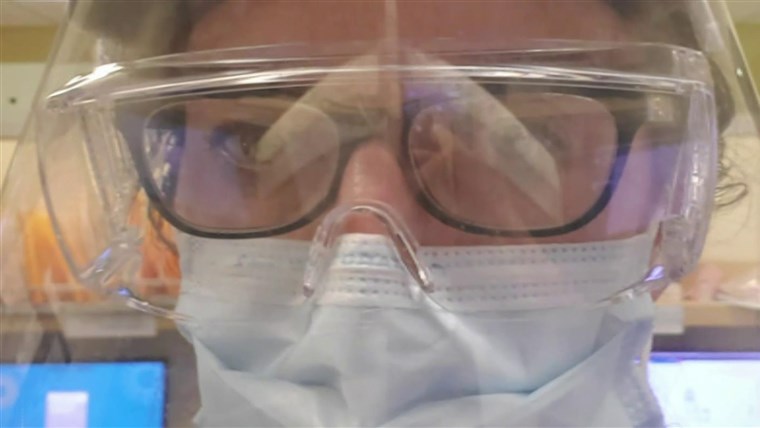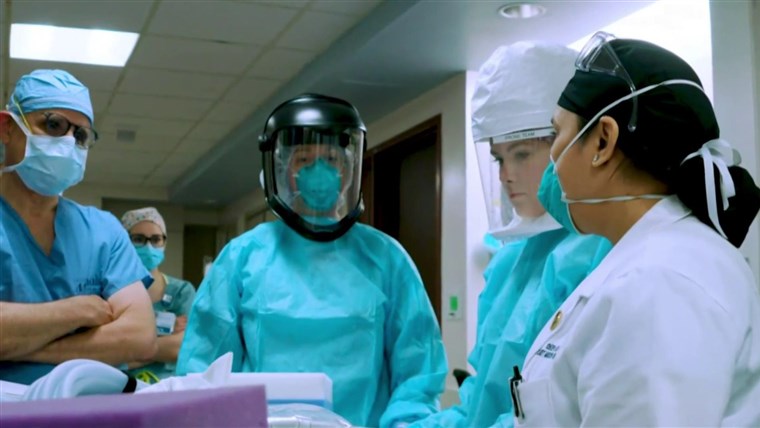WASHINGTON — The federal government may not have the capacity to supply medical professionals with personal protective equipment amid the latest surge in coronavirus cases, according to internal administration documents obtained by NBC News.
For example, the Strategic National Stockpile and the Federal Emergency Management Agency have fewer than 900,000 gloves in reserve after shipping 82.7 million of them — or just 30 percent of the amount requested by state, local and tribal governments — since the COVID-19 crisis began, according to figures compiled Sunday by Health and Human Services Department officials for senior leaders of the interagency coronavirus task force effort.
In particular, nursing homes and long-term care facilities say there is a major personal protective equipment shortage.
“Currently, nearly 20 percent of nursing homes report to CDC [the Centers for Disease Control and Prevention] that they either do not have or have less than a one-week supply of PPE, and more than half of assisted living communities have less than a two-week supply of N-95 masks and gowns,” Mark Parkinson, president and CEO of the American Health Care Association and the National Center for Assisted Living, wrote in a letter to governors Tuesday. “N-95 masks are still not available and were not included in the FEMA shipments to nursing homes.”
Chaun Powell, a senior official at the health care consulting group Premier Inc., which works with hospitals and other health care providers, said his firm is no longer confident that current federal inventories are sufficient to meet the additional increases in demand.
“Our primary focus for our 4,000 hospitals and 175,000 non-acute members has shifted to conservation until we see additional output” from private-sector manufacturing, he said in an email.
The disclosure comes as President Donald Trump and senior administration officials pressure state and local governments to reopen commerce — and prepare to open schools in the fall — despite rising fatalities, hospitalizations and rates of infection in major metropolitan areas and small towns across the country.
Nonetheless, Adm. John Polowczyk, the chief supply-chain official for the White House coronavirus task force, maintained in an interview with NBC News on Tuesday that the supply situation is “just not that dire.”
“I’m not going to pretend to tell you that supply and demand are perfectly aligned again, because there is still some residual hunting and pecking for a few things,” he said. “But supply and demand back orders are trending typically down, and we’re fundamentally in a volume place differently than we were in, say, March and then very early April.”
Polowczyk said that the federal government has orders for 4.5 billion gloves that he said he expects to be fulfilled between now and mid-September, adding that states and hospital systems have been able to cover most of their needs through the commercial marketplace and the Defense Logistics Agency. He also said that outstanding requests from states for various pieces of equipment have been turned over from FEMA to the DLA, along with hundreds of millions of dollars in purchasing power.
Some state and local officials agree that they are getting what they need now.
“Things have meaningfully changed,” Santa Cruz County, Arizona, Supervisor Bruce Bracker said. “In March we were looking for any [PPE] source, we were looking for any place to find this stuff and it was tough. Now we have a lot of suppliers who are saying, ‘Hey, we have this and that.’ In the meantime we’ve gotten enough supplies through the state.”
The area where the administration’s data show the greatest success in meeting the needs of state and local governments is in the procurement of face coverings.
The stockpile and FEMA have 56 million N-95 or KN-95 respirators in reserve, and have fulfilled 92 percent of those requests — sending out more than 130 million masks — while companies including 3M, Honeywell and Owens & Minor are ramping up production. With other goods, such as the millions of Tyvek coveralls the HHS Department bought for twice the price its supplier paid and face shields, the administration sent out more than the number requested.
Still, after months of Trump playing down the public health risk of the disease, and proclaiming the federal response a shining success, the administration’s internal data suggest the federal government’s ability to help meet any major surge in demand is limited.
Between FEMA and the national stockpile, there are 329,000 pairs of goggles on hand, and the administration has only been able to provide 29 percent of the 4.9 million requested by state and local governments so far, according to the tables. Similarly, 8.5 million gowns are warehoused — the HHS Department did not break down how many are surgical and how many are nonsurgical — while only 5.2 million of the 17.9 million surgical gowns requested (29 percent) have been shipped out.
The administration has also struggled in its efforts to procure body bags. State and local governments have requested 175,797 of them, according to the HHS data, but only 69,067 have been provided. One federal order for 100,000 human remains pouches was rescinded earlier this year after the contractor defaulted on the deal, according to federal records. DLA has been able to supply some of the orders.
The Department of Homeland Security reported in one of its regular updates that more than one quarter of U.S. states have less than a 30-day supply of personal protective equipment on hand, according to another document created by the HHS Department for task force officials.
Polowczyk said he had been misconstrued on that point in recent congressional testimony. Roughly 70 percent of states have 60 to 90 days of supply, he said, with the rest split between those that have more than 90 days and those that have 30 days and are still trying to get localities up to the same level.
Polowczyk said he now has visibility into the entire medical supply chain and he’s not seeing problems at major hospital systems.
“We’re getting hospital-level information and they are required to report, from the CARES Act, specific hospital things like ICU beds, ICU bed usage, COVID patients, days of supply on hand,” he said. “That information from March until now has completely greened up, and green is ‘do you have more than 15 days of supply?’”
But The Washington Post reported Tuesday that the administration is considering asking governors to send in National Guard troops to assist hospitals with that data collection because it has been insufficient. Hospitals, the Post reported, blame the HHS Department for a shifting set of criteria.
Polowczyk also said that he is unhappy with the senior leadership briefing documents.
“I was just talking to the staff last night,” he said. “I don’t like that way that they’re displaying information, and they’re gonna go to change them.”
Allen reported from Washington, and Farivar from Oakland, Calif.




